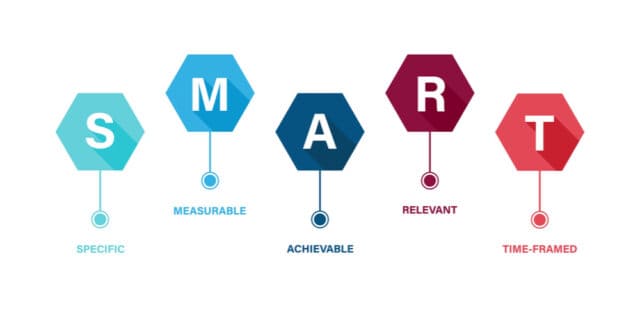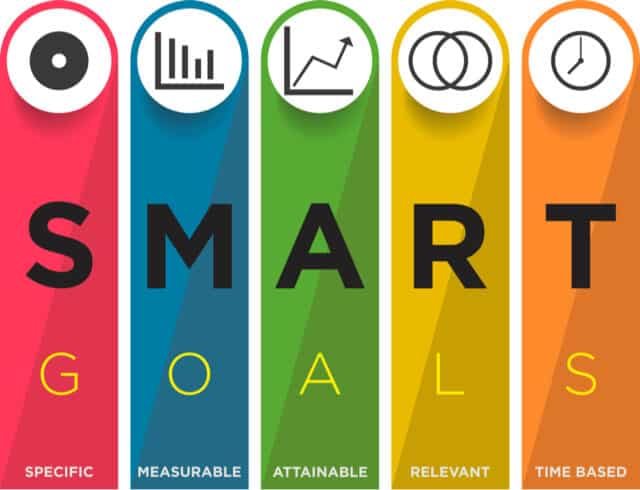SMART Marketing Goals: How to set tactical marketing plans for the business?
What comes to mind when you hear the phrase “marketing strategies” or “SMART marketing goals”?

Marketing objectives or marketing tactics are crucial components in ensuring your company’s success and achieving business goals. Most businesses have them, but the majority of them aren’t smart enough to be successful. Smart marketing objectives are those that are both actionable and quantifiable.
Have you ever made marketing strategies and marketing plans and started wondering why they weren’t achieving their marketing objectives? When goals aren’t logical or achievable, they’re doomed to fail. You need SMART goals to make your marketing smarter. We’ll break up each element of every goal, and explain to you how to get more leads, identify pain points, save time, create a sensible marketing budget plan, and overcome new challenges.
What does SMART stand for?
SMART stands for Specific, Measurable, Attainable, Relevant, and Time-bound. These are the fundamental components of any effective marketing strategy. They ensure that your annual marketing plan or business objectives are well thought out and achievable.
Specific
Your marketing goal and target audience should be clear and concise. You can’t expect to reach a broad audience if you don’t know who or what it is you want to reach!
Measurable
The end result of your marketing strategies must be something measurable. This means you’ll need a way to determine whether your marketing campaigns were successful or not. For example, suppose your business sells widgets and you need to meet sales goals.
You’ll need to measure the clicks received by your target audience. Did your business receive more leads? How many people visited your company website? Did they complete an order form?
Attainable
It’s easy to set unattainable goals. But if they aren’t realistic, you won’t get anywhere with them. Do a situation analysis. Make sure your goals are attainable by your budget, and staff, and are within a time frame.
Relevant
Your marketing goals must be relevant to your brand, product, and business goals. For example, if you’re selling widgets, your business goals shouldn’t be “increase sales.” Instead, your marketing objectives should be to focus on increasing sales among certain demographics (i.e., women over 50).
Time-bound
Like all good things in life, your business goals should come with deadlines. Marketing campaigns take time. However, you can’t just sit back and wait until everything goes perfectly before launching a new digital marketing campaign. Set a deadline for each marketing plan so you can track the progress toward meeting your overall goal.
What are the benefits of setting SMART marketing goals?

Setting realistic goals is the most crucial component of any marketing strategy. If you don’t set business goals, you won’t know if you’ve succeeded or failed. To ensure success, set SMART goals.
SMART goals help you develop a marketing plan that meets your needs while keeping you focused on achieving results. They also make your marketing strategy more accountable. Setting business goals gives you a reason to do what you need.
And when you see the results of your work, you have proof that you were right to spend your time and money on this particular project. SMART goals are also useful because they serve as benchmarks against which you can measure your performance. If you fail to hit your target, you can adjust your marketing tactics or strategy accordingly.
Smart marketing goals are benchmarks to aim for. They’re a catalyst to successful marketing campaigns because they improve communication within a team. It motivates everyone involved and helps you reach your target audience faster.
Setting the SMART goals is a great way to ensure that your marketing objectives have a clear purpose. It allows you to concentrate on what is most important in achieving your overall business objectives. It can also assist you in determining the effectiveness of your marketing campaign.
How should SMART objectives be evaluated and tracked?

Setting goals can be very effective. When done right, they’re known to help you achieve great things. The key to setting goals is to ensure they are SMART goals. Sales are the most useful tool for assessing success.
If you’ve set yourself a goal to increase your sales by 20%, you can track this by looking at your monthly sales figures. This provides a quick overview of your progress.
Set objectives both for earnings and your product
Any marketing strategy should look to enhance sales. However, it is critical to examine the effect of your marketing efforts on the image of your brand. You may not want to spend all of your advertising budget if you want to create a solid reputation for yourself.
Instead, you might want to focus on building relationships with customers through social media, word of mouth, and other channels. You may also allocate some money for this in your annual marketing plan.
Determine key performance indicators KPIs
KPIs are the most important metrics that you need to measure and track in order to make informed decisions about your company’s future. The most common KPI is sales revenue. Other metrics include customer satisfaction, conversion rates, and lead generation. Before setting SMART goals, it is necessary to recognize what these KPIs mean for your business.
For example, if you want to increase your sales by 20% over the next 12 months, this would be an attainable goal. However, if you want to double your revenue within 2 years, this would be a more ambitious target.
Define your marketing objectives

Once you know what you want to achieve with your marketing strategy, you can start defining your business objectives.
These should use both long and short objectives. Short-term objectives are usually defined as one year, while long-term objectives may span several years.
Identify your marketing channels
After you’ve identified your marketing goals, you can start thinking about how you’ll achieve them. This could involve developing a digital marketing plan, a content calendar, identifying potential partners, and even creating a marketing budget plan.
Create your marketing plans

Coming up with strategies that help you to reach your goals is among the most crucial components of beginning a business. Set goals! Consider the most critical goals you want to attain in the short and long run and create plans to achieve them. This can be intimidating, particularly if you’re beginning from zero. However, don’t worry; there are lots of resources available to assist you. Now that you have established your objectives and chosen your channels, you can create a detailed marketing plan. You should consider all aspects of your campaign, including:
- Your message.
- Who you are targeting?
- Are you targeting the existing customers or planning to generate more leads?
- Where you are placing your ads?
- How much is your marketing spend?
- Are you going to use any particular tools or processes?
- When do you expect to achieve the results?
Set time frames and deadlines
Finally, once you have created your plan, you need to set realistic timeframes and deadlines. You won’t get anywhere if you wouldn’t adhere to your schedule! Setting SMART goals ensures that your marketing performance matches your organization’s goals.
By using SMART goals, you are ensuring that you are spending your resources effectively.
Assess the ability to accomplish your goals
The best way to assess whether your tactical marketing plan is effective is by measuring it against your overall marketing strategy. If your goal was to increase sales, your tactical marketing plan should include a number of activities designed to drive traffic to your website and boost conversion rates.
Designate short and long-term marketing goals
Goals are actionable, and that is what makes them valuable. They allow you to look at your business in terms of realistic targets and expectations. In doing so, they help you set benchmarks for evaluating your success. The tactical marketing plan should include at least two years of planning. It should detail what you want to accomplish during this period, including both short-term and long-term goals.
Strategic Marketing Vs Tactical Marketing

Strategic marketing is a long-term approach to marketing that focuses on building relationships with current and potential customers. It is all about developing a strategy and vision for your brand. It involves long-term planning and thinking through what it takes to build and sustain a successful brand.
Tactical marketing is all about executing that vision by using short-term tactics to reach your goals. The main goal of tactical marketing is to increase sales.
Both approaches should complement one another. If you want to introduce a new product, for instance, you should first conduct market research. This will assist you in determining who would gain from your product. You can then strategize based on demographics to approach them.
What is the Tactical Marketing Plan?
Tactical marketing involves using a variety of methods to create awareness among consumers. Email marketing, generating leads, social media management, search engine optimization, content generation, and website design are the most common tactical marketing activities.
Advertising
The most common form of tactical marketing is advertising. Print advertisements, radio commercials, tv advertisements, and hoardings are common forms of advertising. However, digital advertising has grown in popularity in recent years. Digital advertising includes things like email campaigns, text messages and online banners.
Public Relations Tactics

Public relations (PR) is similar to traditional advertising because both involve promoting a particular brand or service. However, PR differs from advertising because it doesn’t necessarily have to focus on selling a product. Instead, PR is often used to build goodwill towards a brand or organization.
As an instance, suppose you own a car repair shop. You want more customers so you can earn more money. One option is to advertise in local newspapers. This could help generate interest in your business.
Another option is to hold a free event at your shop. People might come out to see what you offer. They’ll learn about your services and they might even decide to hire you for future repairs.
Search Engine Optimization (SEO) Tactics
Search engine optimization is an effective way to attract visitors to your website. SEO works by optimizing websites to rank highly in search results. To accomplish this, specific regulations must be followed. When it relates to SEO, there really are two types: offsite SEO and onsite SEO.
Offsite SEO refers to activities that take place outside of your website. Examples include link building, content creation, and social media engagement. Onsite SEO refers to activities related to your website itself.
Link Building
Link building is among the most crucial components of SEO. Link building occurs when someone links his or her site to yours. Links are essential “votes” for your website. The more votes you receive, the better your ranking will be. You can gain these votes in several ways. First, you can request that the other websites link to yours.
Second, you can write articles and submit them to article directories. Third, you can create blogs and share them on social media platforms. Fourth, you can participate in forums and comment on relevant topics. Finally, you have the option of purchasing backlinks from many other online sites.
Content Creation
Another key aspect of SEO is creating quality content. Everything from blog entries to press releases to web pages is considered content. Content of high quality can help you perform better in search engines. Consider hiring a freelance writer or editor if you really do not know how to make high-quality content.
Social Media Engagement

Communications through social media are already among the most widely used methods. Many people use social media platforms like Facebook, LinkedIn, Twitter, Instagram, and YouTube to stay connected with friends and family.
Use social media to connect with your target audience and attract them to your website. Marketing via social media is a highly effective strategy. It enables companies to communicate effectively with clients. Through social media, companies can post information about themselves, answer questions, and provide customer support.
Social media is a fantastic tool for engaging current and prospective customers. You’re passing up a huge opportunity when you’re not utilizing social media to advertise your products and services.
Why You Need Strategy Before Tactics

The best way to understand this concept is to think of it as a recipe. If you want to bake cookies, you don’t just start mixing ingredients together; you need to first decide what kind of cookie you want to make. This includes deciding whether you want chocolate chip cookies, brownies, sugar cookies, etc. Once you know what type of cookie you want to bake, you can choose from a variety of baking recipes available online.
Identify tactics for implementing your digital marketing strategy
Once you’ve identified your overall goals, you’ll have to identify the tactics you’ll use to reach them. For example, if you want to increase traffic to your website, you may choose to publish new blog posts every week. Or, if you want to sell more products online, you might decide to offer free shipping on all orders over $30. Once you have a list of tactics, you can start planning how they’ll work together.
Some strategies might not work well together. For example, offering free shipping only on items that cost more than $30 would likely result in fewer sales.
To make sure that each tactic contributes to achieving your overall goal, you should evaluate whether it’s working or not. This means tracking metrics such as the number of visitors who click through to your website after viewing an ad, the number of leads generated by a particular email campaign, etc. As you implement different tactics, keep track of what works best. Once you have a good idea of which tactics are effective, you can begin to combine them into a comprehensive digital marketing strategy.
What is personal marketing?
In a professional context, personal marketing is any form of self-promotion that happens outside of a business setting. It’s the act of using social media, networking, and other tactics to make yourself stand out from the crowd and get people to remember you. Connecting people, for instance, via social networking sites like Quora, Facebook, Tumblr, YouTube, LinkedIn, Pinterest, Twitter, etc.
Personal marketing creates an unbreakable link between you and your fans so that they will keep coming back for more. It is critical to ensure that your brand is highly visible and available to prospective consumers.
The core elements of a personal marketing plan

Your personal marketing plan is dictated by your mission statement and a vision that you build. These form the core elements of every good marketing strategy. A personal marketing plan should include all the information needed to understand what it takes to market yourself successfully. This includes the following:
Your vision statement
A vision statement reveals your purpose and why you are doing work. It’s what energizes you, reminds you of your strengths, and inspires you to take action.
Your mission statement
The most important thing to remember is that your mission statement will be the guiding principle behind everything you do, and everything that you create. Your mission statement is a very important component of a marketing plan, especially when you’re just starting to market yourself and your product.
Ways To Use & Share Your Personal Marketing Plan
The best way to develop a personal marketing plan is to think through what you want from your career and start planning accordingly. Once you know where you want to take your career, it’s easier to determine which skills you should focus on developing.
The best time to share your personal marketing plan is right after it has been created. This might take a little time to perfect your strategy, but once you have, it should be simple to share with others. If you wait too long, people may forget what they were supposed to do, and if you share it too early, you risk losing momentum.
Subscribe to our Newsletter
Sign up to receive email updates on new product announcements, exclusive sales and marketing content, special offers on email validation plans, and more.
We send curated content as per your preference and do not indulge in spam!
What would you like to know about
We’re committed to your privacy. TuxMailer uses the information you provide to us to contact you about our relevant content, products, and services. You may unsubscribe from these communications at any time. For more information, check out our privacy policy.



